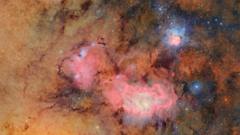In April, claims emerged from a group of astronomers suggesting they had discovered potential indicators of life on K2-18b, a planet located over 120 light-years away. This assertion captured global excitement and curiosity, prompting extensive examination by the scientific community. Subsequent analyses, however, have left researchers with a clearer perspective: the evidence for life on K2-18b is now considered inconclusive.
Luis Welbanks, an astronomer at Arizona State University involved in one of the independent studies, stated, “The claim just absolutely vanishes,” reflecting the collective consensus among researchers. Their findings arose from a recent wave of scrutiny in the field of astronomy, sparking discussions not merely about the possibility of alien life but also about the methods employed to analyze far-off planets.
Observing distant worlds like K2-18b presents unique difficulties. Unlike nearer planets such as Jupiter, which can be observed by reflected sunlight, K2-18b is too far away for either direct observation or standard telescopic methods. Astronomers utilize sophisticated techniques to extract data from these distant planets, including analyzing stellar wobbles and the gravitational influences of orbiting bodies.
For example, a significant breakthrough occurred in 2010 with the discovery of GJ 1214b, situated 48 light-years from Earth, when astronomers analyzed its transits in front of its star. This method allowed them to discern specific wavelengths of absorbed light, suggesting the presence of water vapor in the planet's atmosphere.
In 2022, the advent of the James Webb Space Telescope revolutionized the field, offering advanced capabilities for observing the intricate patterns of light from distant solar systems. This investigation has given scientists new insights, though it has also underscored the inherent challenges in validating claims about extraterrestrial phenomena.
As the debate over K2-18b continues, the ongoing pursuit of understanding the cosmos reflects both the limitless curiosity of humankind and the rigorous scientific process required to draw conclusions about life beyond our planet.























